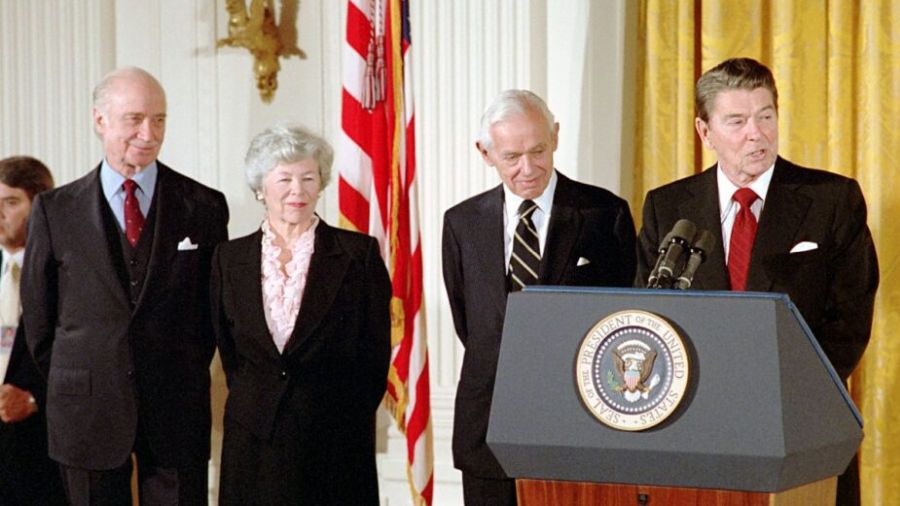From Trotskyism to Radical Positivism: How Albert Wohlstetter Became the Leading Authority on Nuclear Strategy for America
The Fabian Society was extremely influenced by the ideas of Darwinism. Much of what they supported in terms of ideologies and philosophies was for the purpose of advancing Darwinism
See Part I for how RAND and its creed “systems analysis” was created and how Albert Wohlstetter would ultimately become the kingpin of RAND.
A Wolf in Sheep’s Clothing: the Fabian Society
For us to understand what ultimately made Albert Wohlstetter the man he became we must first start with the story of Bertrand Russell. And for this, we must begin with the Fabian Society.
The Fabian Society was founded on January 4th, 1884 in London as an offshoot of The Fellowship of the New Life, which in turn was founded just one year earlier by Scottish philosopher Thomas Davidson. The Fellowship advocated pacifism, vegetarianism and simple living, under the influence of Leo Tolstoy’s ideas. (1) Some of its members also wanted to become politically involved in transforming society which led to the formation of the Fabian Society.
One of the nine founding members of the Fabian Society was Frank Podmore, who was also an influential member of the Society for Psychical Research.
Alfred Russell Wallace, William Crookes, F.W.H. Myers and renown psychologist William James’ work on mediums, telepathy and materializations led to the founding of the Society of Psychical Research, the Theosophical Society and their American branches.
Alfred Russell Wallace was a close associate of T.H. Huxley (Darwin’s bulldog) and co-founded the theory of natural selection alongside Charles Darwin.
The Fabian Society was extremely influenced by the ideas of Darwinism. Much of what they supported in terms of ideologies and philosophies was for the purpose of advancing Darwinism and saw Karl Marx’s newly published system as the perfect vehicle to carry Darwin’s logic into a controlling ideology to organize the masses.
Karl Marx himself was very much drawn to the ideas of Darwin, including two explicit references to Darwin and evolution in the second edition of Das Kapital. (2)
Marx would write in a letter that:
“Darwin’s work is most important and suits my purpose in that it provides a basis in natural science for the historical class struggle.”
In a book review of the first volume of Das Kapital, Engels wrote that Marx was “simply striving to establish the same gradual process of transformation demonstrated by Darwin in natural history as a law in the social field.” (3)
The Fabian Society would define itself as a socialist movement, influenced by Karl Marx and the Marxist Social Democratic Federation soon founding England’s Labour Party in 1900. The party’s constitution was written by Fabian Society leader Sidney Webb and borrowed heavily from the founding documents of the Fabian Society.
Immediately upon its inception, the society featured such prominent eugenicists such as George Bernard Shaw, Thomas Huxley’s protégé H.G. Wells, Arthur Balfour, founder of Geopolitics Halford Mackinder and Bertrand Russell.
Prominent Theosophist Annie Besant would also become a member of the Fabian Society upon its inception, and was the leading speaker for both the Fabian Society and the Marxist Social Democratic Federation.
At the core of the Fabian Society were Sidney and Beatrice Webb, who would also help co-found the London School of Economics (LSE), with Rothschild funding, to propagate the Fabian Society outlook in 1895.
Harold Laski, one of Britain’s most influential intellectual spokesmen for Marxism, would become a Fabian Society member, a professor at the LSE (1926-1950), and a chairman of the British Labour Party (1945-1946).
Bertrand Russell would teach social democracy at LSE from 1895-1896 and from 1937-1938 lectured on the science of power. On the official site of LSE, Russell is credited as “one of the spiritual and financial founders of LSE…[whose] involvement in the early life of the School helped to define its ethos.”
The Coefficients club was also set up by Sidney and Beatrice Webb and included among its membership H.G. Wells and Bertrand Russell, as well as Leo Amery, Harold Laski, Halford Mackinder (who was Director of the LSE from 1903-1908), Alfred Milner and Clinton Edward Dawkins (the three times great uncle to the British evolutionary biologist Richard Dawkins).
The name “Fabian” is derived from the Roman General Quintus Fabius, known as the Cunctator from his strategy of delaying his attacks against the invading Carthaginians until the right moment, and who’s fame is founded on having beaten Hannibal by never engaging in direct combat.
In the founding Fabian document it is written: “For the right moment you must wait, as Fabius did most patiently, when warring against Hannibal, though many censured his delays; but when the time comes you must strike hard, as Fabius did, or your waiting will be in vain, and fruitless.”

Fabians would advocate the strategy of permeation, whereby you affect the change you want to see by slowly permeating all levels of society’s controlling structures. Once you have permeated sufficiently you can strike collectively and essentially take over from within. It would be a technique that the Trotskyists would become notorious for, such as with the French Turn.
As Matthew Ehret wrote in his “Origins of the Deep State”:
“The Fabian society program focused on broad social welfare programs such as universal health care, mass education, and better working conditions which were designed to attract the disenfranchised masses. Under the Fabian program, such programs held no substance in reality, as the true means to justify their creation was banned…[that is]…true scientific and technological progress…
This ruse was thus designed to merely bring the will of the lower classes under the deeper influence of a ruling oligarchy via the promise of ‘democratic socialism’ and a naïvely utopian ‘end of history’ ideal…The controllers of Fabian Socialism are not, nor have they ever been ‘democratic socialists’…”
At its heart, Fabianism was merely fascism with a “scientific” socialist face.
Matthew Ehret writes:
“The Round Table movement served as the intellectual center of the international operations to regain control of the British Empire and took on several incarnations over the 20th century. It worked in tandem with the Coefficients Club, the Fabian Society, and the Rhodes Trust, all of whom witnessed members moving in and out of each others ranks.”
Historian Carrol Quigley, wrote of this cabal in his posthumously published “Anglo-American Establishment”:
“This organization [the Round Table]…has been the most powerful single influence in All Souls, Balliol, and New Colleges at Oxford for more than a generation…it had a great deal to do with the formation and management of the League of Nations and of the system of mandates; it founded the Royal Institute of International Affairs in 1919 and still controls it.”
H.G. Wells was chairman of the League of Free Nations Association and published his call for “world peace” in his book “The Idea of a League of Nations” published in 1919.
The purpose was again to lure people in with glorious promises of a “social democracy” while in fact weakening nation states such that they would be unable to resists the coming of a new world empire.
H.G. Wells would publish “The New World Order” in 1940, and was no doubt the guiding influence on Julian Huxley’s outlook when he wrote the manifesto for UNESCO.
Bertrand Russell’s “Proposed Roads to Freedom”
In 1918, Russell publishes “Proposed Roads to Freedom: Socialism, Anarchism and Syndicalism”. Here are some relevant quotes:
“My own opinion – which I may as well indicate at the outset – is that pure Anarchism, though it should be the ultimate ideal, to which society should continually approximate, is for the present impossible…On the other hand, both Marxian Socialism and Syndicalism, in spite of many drawbacks, seem to me calculated to give rise to a happier and better world than that in which we live. I do not, however, regard either of them as the best practicable system…The best practicable system, to my mind, is that of Guild Socialism, which concedes what is valid both in the claims of the State Socialists and in the Syndicalist fear of the State by adopting a system of federalism among trades for reasons similar to those which have recommended federalism among nations.”
“The terrorist campaign in which such men as Ravachol were active practically came to an end in 1894. After that time, under the influence of Pelloutier, the better sort of Anarchists found a less harmful outlet by advocating Revolutionary Syndicalism in the Trade Unions and Bourse de Travail.”
“In England Marx has never had many followers. Socialism here has been inspired in the main by the Fabians…What remained was State Socialism and a doctrine of ‘permeation.’ Civil servants were to be permeated with the realization that Socialism would enormously increase their power. Trade Unions were to be permeated with the belief that the day for purely industrial action was pasts, and that they must look to Government (inspired secretly by sympathetic civil servants) to bring about, bit by bit, such parts of the Socialist programme as were not likely to rouse much hostility in the rich. The Independent Labour Party…was largely inspired at first by the ideas of the Fabians…It aimed always at cooperation with the industrial organizations of wage-earners, and chiefly through its efforts, the Labour Party was formed in 1900 out of a combination of the Trade Unions and the political Socialists. To this party, since 1909, all the important Unions have belonged, but in spite of the fact that its strength is derived from Trade Unions, it has stood always for political rather than industrial action.”
“Anarchism, which avoids the dangers of State Socialism, has dangers and difficulties of its own…Nevertheless it remains an ideal to which we should wish to approach as nearly as possible, and which, in some distant age, we hope may be reached completely…The system we have advocated is a form of Guild Socialism, leaning more, perhaps, towards Anarchism than the official Guildsman would wholly approve. It is in the matters that politicians usually ignore – science and art, human relations, and the joy of life – that Anarchism is strongest… ”
In his “Proposed Roads to Freedom” Russell makes it clear that he is most sympathetic to the philosophy of Mikhail Bakunin and Prince Kropotkin, who were both involved with the Mounte Verità society, a sister branch to the Theosophists (refer here for the relevance of this).
Interestingly, Russell’s proposed roads to freedom, that is, socialism, anarchism and syndicalism all lead to the same destination point…the League of Nations.
Russell writes:
“If the peace of the world is ever to become secure, I believe there will have to be, along with other changes, a development of the idea which inspires the project of a League of Nations.”
Thus, Russell is all for minimising the power of the State until we can reach the “ideal,” in the form of a world empire.
The Unity of Science: Radical Positivists, Eugenicists, and Anarchists Unite
The Vienna Circle of Logical Empiricism was a group of philosophers and scientists who met regularly from 1924 to 1936 at the University of Vienna. The Vienna Circle’s influence on 20th-century philosophy, especially philosophy of science and analytic philosophy, is immense up to the present day.
The philosophical position of the Vienna Circle was called logical empiricism (aka: logical positivism). It was greatly influenced by such members as Ernst Mach, David Hilbert, and Bertrand Russell. The Vienna Circle was committed to the ideals of the Enlightenment and its aim was to make philosophy “scientific” with the help of modern logic.
This was very much along the line of what David Hilbert (member of the Vienna Circle) had called for at the International Congress of Mathematicians in 1900, whereby Hilbert put forth the thesis that all scientific knowledge should be reduced to the form of mathematical “logic.” Thus, all “scientific” knowledge would henceforth be solely deducible from mathematical models.
In 1900, Bertrand Russell and Alfred North Whitehead (who taught Russell) set forth to achieve Hilbert’s challenge which resulted in the three volume “Principia Mathematica” published thirteen years later. The Principia would be the new Bible in many ways for generations of analytical philosophers and logical positivists.
Continuing along these lines, the Unity of Science Movement was organized in the late 1930s by former members of the Vienna Circle of Logical Empiricists, such as Rudolf Carnap, Otto Neurath, and new members such as Ernest Nagel. The greatest aim being to create an encyclopedia that would establish how the unity of sciences should proceed, bringing together intellectuals to establish a fortress against the chaotic terrain of politics, which was extremely adverse to the “ideals” of a scientific way of life. All contributors to this process agreed that the progress of science should eventually create a “scientific world-conception,” helping to build (or control) a big picture of what science means.
“Encyclopedia and Unified Science” would be published by the movement with this aim. The first edition came out in 1938 and was co-written by Otto Neurath, Rudolf Carnap, Charles Morris, John Dewey, Niels Bohr and Bertrand Russell.
Interestingly, science fiction was considered just as important as the logic of science to this world-conception.
Though H.G. Wells was not an official member of this movement, we should keep in mind that he was always committed to the same goals as Russell. Wells was not only a world famous writer of science fiction, but was also working on his own new secular Bible series in three books designed to unite all forms of knowledge. (4)
Among this trilogy is “The Science of Life” co-written with Julian Huxley, and meant to give a popular account of all major aspects of biology as known in the 1920s. It is credited with introducing modern ecological concepts and emphasised the importance of behaviourism and Jungian psychology (Jung was a member of the Mounte Verità society).
It also promoted Eugenics.
Julian Huxley, Vice President (1937-1944) and President of the British Eugenics Society (1959-1962) was the one to coin the term “transhumanism.” Julian was also the first director-general of UNESCO (United Nations Educational, Scientific and Cultural Organization) in 1946, to which he wrote its mandate “UNESCO: Its Purpose and Its Philosophy.”
Norbert Wiener was taught by Bertrand Russell at Cambridge and by David Hilbert at the University of Göttingen. He would go on to found “cybernetics.”
John Dewey, a member of the Unity of Sciences movement, would greatly dictate and shape a global educational reform, which was promoted by UNESCO, and has immense influence to this day.
It was clear that along with a world government, you would need a world-conception of what is regarded or approved of as “scientific,” all else would be thrown into the dust bin and would be considered unfit to shape policy. This was enforced by the construct of a global education system to implement the “right” sort of ideas and forbid the “wrong” sort.
Russell would put it forth most succinctly in his “The Scientific Outlook” (1931):
“The scientific rulers will provide one kind of education for ordinary men and women and another for those who are to become holders of scientific power. Ordinary men and women will be expected to be docile, industrious, punctual, thoughtless and contented. Of these qualities, probably contentment will be considered the most important. In order to produce it, all the researchers of psycho-analysis, behaviorism and biochemistry will be brought into play… all the boys and girls will learn from an early age to be what is called “cooperative” i.e.: to do exactly what every body else is doing. Initiative will be discouraged in these children, and insubordination, without being punished will be scientifically trained out of them.”
In 1953, Russell would update this creepy piece of work and make it even creepier, writing:
“It may be hoped that in time anybody will be able to persuade anybody of anything if he can catch the patient young and is provided by the State with money and equipment… This subject will make great strides when it is taken up by scientists under a scientific dictatorship. Anaxagoras maintained that snow is black, but no one believed him. The social psychologists of the future will have a number of classes of school children on whom they will try different methods of producing an unshakable conviction that snow is black. Various results will soon be arrived at. First, that the influence of home is obstructive. Second, that not much can be done unless indoctrination begins before the age of ten. Third, that verses set to music and repeatedly intoned are very effective. Fourth, that the opinion that snow is white must be held to show a morbid taste for eccentricity. It is for future scientists to make these maxims precise and discover exactly how much it costs per head to make children believe that snow is black, and how much less it would cost to make them believe it is dark gray.”
If you think that sounds awfully similar to Aldous Huxley’s “Brave New World,” it is because it is, in fact Russell was contemplating charging Aldous with plagiarism.
Albert’s Radical Days
Albert Wohlstetter started at City College of New York (CCNY) in 1931. It was here that he would be mentored by Morris Raphael Cohen, a professor of philosophy and mathematics and a Russian émigré with a nihilist background.
In the 1930s, City College had developed a reputation as the “proletarian Harvard,” and this was very much due to Cohen, who started a Marx Circle at CCNY. This Marx Circle met regularly at the Henry Street Settlement House, which had been established by followers of the Fabian Society.
The Henry Street Settlement House was purchased by Jacob Schiff in 1895, likely through Rothschild funding (recall Rothschild also funded the London School of Economics which was started by the leading Fabians Sidney and Beatrice Webb). By the 1930s the settlement house was being used for classrooms and residences. Schiff was a financier who went on to receive the Medal of the Rising Sun from Japan in exchange for providing $200 million for the Japan-Russo war and then went on to pour millions into the Bolsheviks that overturned Czarist Russia in 1917.
While a Professor of Philosophy at CCNY (1912-1938), Morris Raphael Cohen came under the influence of philosopher Thomas Davidson, founder of the Fellowship of the New Life from which the Fabian Society arose in 1884. Cohen’s “Marx Circle” continued within Davidson’s enterprise. Cohen also studied under William James, co-founder of the Society for Psychical Research (connections to the Theosophists), while at Harvard University.
Cohen was also strongly influenced by Bertrand Russell, who in turn held Cohen in high regard. Cohen would write in his autobiography “A Dreamer’s Journey”:
“It was the study of Russell’s Principia Mathematic which I began soon after I was appointed to teach mathematics at City College in 1902, that finally liberated me…Russell came closer to being my philosophical god than any one before or since…”
Cohen would also mentor Ernest Nagel and Sidney Hook at CCNY. All of these men were close mentors/friends to Albert Wohlstetter. Hook would become a leader of the Marxist faction at CCNY.
Nagel cowrote “An Introduction to Logic and the Scientific Method” with Morris Raphael Cohen, in 1934.
Ernest Nagel, one of the founders of the Unity of Science Movement, earned his PhD from Columbia University in 1931 and went on to spend his academic career there, becoming the first John Dewey Professor of Philosophy at the University in 1955.
Upon graduating from City College in 1934, at the age of twenty- one, Albert enrolled at Columbia Law School. Albert abandoned law school, after a year, for a graduate program in mathematics. He wrote his MA thesis under the supervision of Ernest Nagel and under the watchful eye of his friend, the philosopher and mathematical logician Willard Van Orman Quine. (5)
Alfred North Whitehead was Willard Van Orman Quine’s thesis supervisor for his Ph.D. in philosophy from Harvard University in 1932. It was Whitehead who introduced Quine to Bertrand Russell which began their correspondence.
Morton White was another one of Ernest Nagel’s doctoral students, and a close friend of Albert (6) who would join the Fieldites (a Trotskyist splinter group) along with Albert.
It should be clear thus far that, Albert was heavily under the influence of the Unity of Science movement thinkers, with Fabian Society overlap, since his days at City College New York.
During Albert’s time as a student at Columbia University (1934-1939), he would become very close friends with militant philosopher and Trotskyist Sidney Hook and found a mentor in Columbia’s highly respected Art Historian and Trotskyist intellectual Meyer Schapiro. (7)
The reader should be aware that Sidney Hook is credited as having converted James Burnham (who, like Hook, was also a professor in philosophy at the New York University) to Trotskyism, acknowledged by Burnham himself in his autobiography. In 1933, along with Sidney Hook, Burnham helped to organize the socialist organization, the American Workers Party (AWP).
In 1934, Trotskyists in the Communist League of America (CLA) did a French turn on the American Workers Party (AWP), in a move that elevated the AWP’s James Burnham into the role of a Trotsky lieutenant and chief adviser.
Sidney Hook earned a Ph.D. in philosophy from Columbia University, under the supervision of John Dewey. It was at Columbia that Hook began the project that was to occupy him throughout the 1930s, of seeking a synthesis between Karl Marx’s “dialectical materialism” and Dewey’s pragmatism.
In the late 1930s, Hook assisted Trotsky in his efforts to clear his name in a special Commission of Inquiry headed by John Dewey, otherwise known as the Dewey Commission.
The Dewey Commission was initiated on March 1937 by the American Committee for the Defense of Leon Trotsky. The commission proclaimed that it had cleared Trotsky of all charges made during the Moscow Trials (8) and made the claim that Stalin had framed Trotsky.
This Commission was a pseudo-judicial process set up by American Trotskyists and its sympathizers. It had no power of subpoena, nor official imprimatur from any government.
Thus, we find a very clear overlap between the Unity of Science Movement and the Trotskyists.
Albert would co-write at least one article with Morton White an article for the “Partisan Review” (9) which was a very influential Marxist magazine that had become more Trotskyist in its leaning. This was due to a new cast of editors, including Dwight Macdonald.
Dwight Macdonald is another close friend of Albert. (10)
Albert would actually join a communist group called the Fieldites, also known as the League for a Revolutionary Workers Party (LRWP), a splinter group from the “official” Trotskyists. In the case of the Fieldites, they had a reputation of having an even more aggressive stance against Stalin’s Soviet Union than the typical Trotskyists. So even more militant.
Interestingly, the founder of the Fieldites was Max Gould (his pseudonym was B.J. Field) a former Wall Street petroleum analyst and graduate from Columbia University. Field had been personally close to Trotsky (11) in the early 1930s and was one of the leaders of the CLA during the heated 1934 period before he was expelled. It was at this point that Field founded the LRWP in May 1934.
The LRWP soon found itself under investigation by the FBI for subversive activities.
Thus, one very big question that comes to mind is, if Wohlstetter was a card carrying member of the LRWP (12), how did he manage top security clearance as a leading nuclear strategist for the RAND Corporation during the McCarthyite era and to which the House Committee on Un-American Activities acted as a standing committee from 1945-1975?
Even Herman Kahn, another prominent RAND nuclear strategist had his security clearance temporarily removed due to his wife’s affiliation with a communist group. So why was Albert’s past never brought up?
Alex Abella offers a possible explanation for this in his “Soldiers of Reason,” where he writes:
“…the records of the group [LRWP] were lost when Field, moving files surreptitiously from an office in a horse-drawn lorry—this was 1934, after all—became involved in an accident at a busy intersection after his horse died. Afraid that he would be charged with the accident and that his radical activities would land him in an even greater jam. Field fled the scene, leaving all the files, publications, and membership rolls to be disposed of by New York City sanitation.”
It is this rather dubious story that is used to explain how all records of the LRWP were lost, never to be found again, and how Albert was very conveniently given a fresh start.
So yes, if we are going to be “fair” with Albert, he was never a faithful Trotskyist, but then again, who ever was? The entire group was notorious for infighting, factions, splintering and permeation tactics, with a long list of renunciations. The importance is rather on what were all these groupings, notably the Fabians, Unity of Science Movement and the Trotskyist all working towards, since it was no coincidence that they were always revolving in each other’s orbits.
Albert was steeped in Marxist doctrine in tandem with the ideologies from the Unity of Science Movement by a network of socialist philosophers that spans three generations, and thus it is absurd to claim that this was all just a coincidence or a “brief” phase of radical experimentation on Albert’s part.
Renunciations, switching titles and mock conversions were all part of the game.
A Road to Damascus? Trotskyists “Convert” to Radical Positivism
James Burnham would remain a “Trotskyist intellectual” from 1934 to 1940. Before this, James Burnham graduated from Princeton, followed by Balliol College, Oxford University (recall Carroll Quigley’s quote on Balliol’s connection to the Round Table and the Fabian Society) before becoming a professor in philosophy at the New York University where he met Sidney Hook and was converted to Trotskyism.
In February 1940, Burnham renounced both Trotsky and Marxism altogether, writing “Science and Style: A Reply to Comrade Trotsky,” explaining his reasons for this and why from now on he would be a follower of Bertrand Russell, Alfred North Whitehead and the new Encyclopedia of Unified Science:
“Do you wish me to prepare a reading list, Comrade Trotsky? It would be long, ranging from the work of the brilliant mathematicians and logicians of the middle of the last century to one climax in the monumental Principia Mathematica of Russell and Whitehead (the historic turning point in modern logic), and then spreading out in many directions – one of the most fruitful represented by the scientists, mathematicians and logicians now cooperating in the new Encyclopedia of Unified Science.”
In 1941, Burnham would publish “The Managerial Revolution” which was a sort of guidebook to Fabian Society thinking at the time of how the world was to be ruled. In fact, Burnham was of the viewpoint that this vision had already won (for more on this refer here).
In his “The Managerial Revolution,” Burnham echoes the Fabian Society methodology and Russell’s “The Scientific Outlook,” writing:
“Nevertheless, it may still turn out that the new form of economy will be called ‘socialist.’ In those nations – Russia and Germany – which have advanced furthest toward the new [managerial] economy, ‘socialism’ or ‘national socialism’ is the term ordinarily used. The motivation for this terminology is not, naturally, the wish for scientific clarity but just the opposite. The word ‘socialism’ is used for ideological purposes in order to manipulate the favourable mass emotions attached to the historic socialist ideal of a free, classless, and international society and to hide the fact that the managerial economy is in actuality the basis for a new kind of exploiting, class society.”
Although Albert would never make such a dramatic public declaration as did fellow technocrat Burnham, it is clear where he ultimately pledged his allegiance by his promotion of systems analysis (part of the trifecta of information theory and cybernetics) behind everything he did at the RAND corporation. (For more on this story refer to Part 1 of this series)
Burnham would go on to work for the OSS, followed by the CIA and would become “the real intellectual founder of the neoconservative movement and the originally proselytizer, in America, of the theory of totalitarianism.”
This helps us to understand why so many of Alfred Wohlstetter’s acolytes were prominent neoconservatives, such as Paul Wolfowitz and Richard Perle.
RAND, under the guidance of Albert Wohlstetter, would gain the power to execute the mission of the Fabian Society. The Hannibal moment of victory had come with their entry into the JFK administration as McNamara’s Whiz Kids, who would not only “manage” the Vietnam War, but all wars that ensued under the American flag.
With entry into the government, they now had access to influencing all national policy including housing, healthcare, and education. Their permeation had become absolute.
Albert and Roberta would continue living in Laurel Canyon (a center of the counterculture movement), promoting an image of Albert as the ever-loving and patient teacher to an endless stream of doting students who would see him as a father figure, rather than for what he truly was, a wolf in sheep’s clothing.
Notes
(1) Colin Spencer (1996), The Heretic’s Feast: A History of Vegetarianism, Fourth Estate, pg. 283.
(2) I. Bernard Cohen (1985), Revolution in Science, Harvard University Press, p. 345.
(3) Ibid.
(4) The three books to H.G. Wells’ self-declared “new Bible” were: “The Outline of History” (1919), “The Science of Life” (1929), and “The Work, Wealth, and Happiness of Mankind” (1932)
(5) Ron Robin (2016), “The Cold War They Made: The Strategic Legacy of Roberta and Albert Wohlstetter,” Harvard University Press, p. 40.
(6) Ibid, p. 38.
(7) Ibid, p. 40.
(8) The Moscow Trials occurred between 1936-1938 and concluded that Trotskyist cells were at the heart of a fifth column operation within Russia which were committed to overthrowing Stalin and bringing Russia into a pro-Fascist program.
(9) Wohlstetter, Albert; White, Morton Gabriel (Fall 1939). “Who Are the Friends of Semantics?”. Partisan Review. 6 (5): 50–57.
(10) Wreszin, Michael (1994). A Rebel In Defense of Tradition: The Life and Politics of Dwight Macdonald. New York: HarperCollins. p. 113.
(11) Ron Robin (2016), “The Cold War They Made: The Strategic Legacy of Roberta and Albert Wohlstetter,” Harvard University Press, p. 45.
(12) Alex Abella (2008), “Soldiers of Reason: The RAND Corporation and the Rise of the American Empire,” Harcourt Books, p. 76.
[Part 3 will go over Albert’s role in shaping the RAND/Whiz Kids management of the Vietnam War, and his relationship to Team B, the false dichotomy of Kissinger vs Brzezinski, and the Trilateral Commission.]







